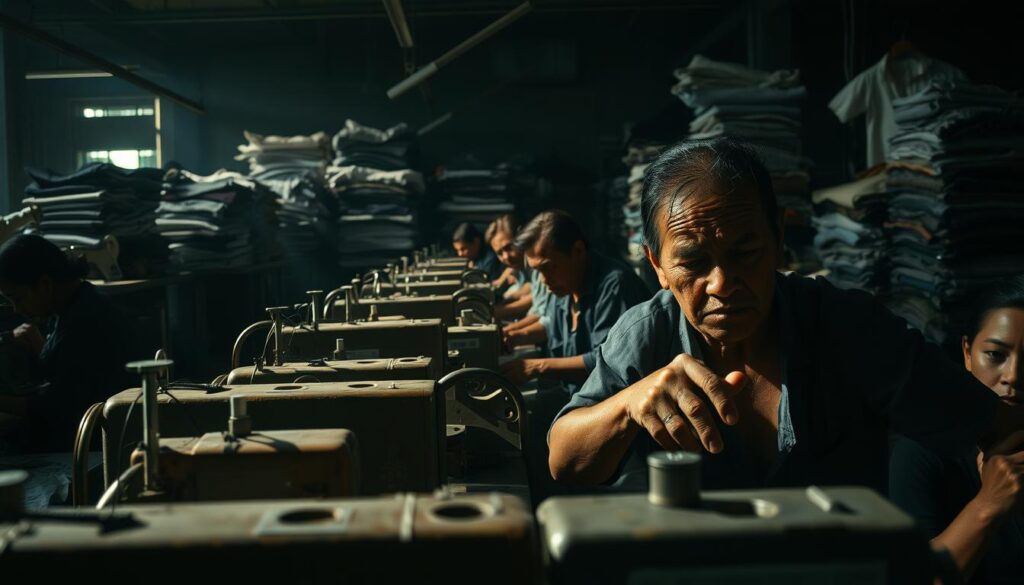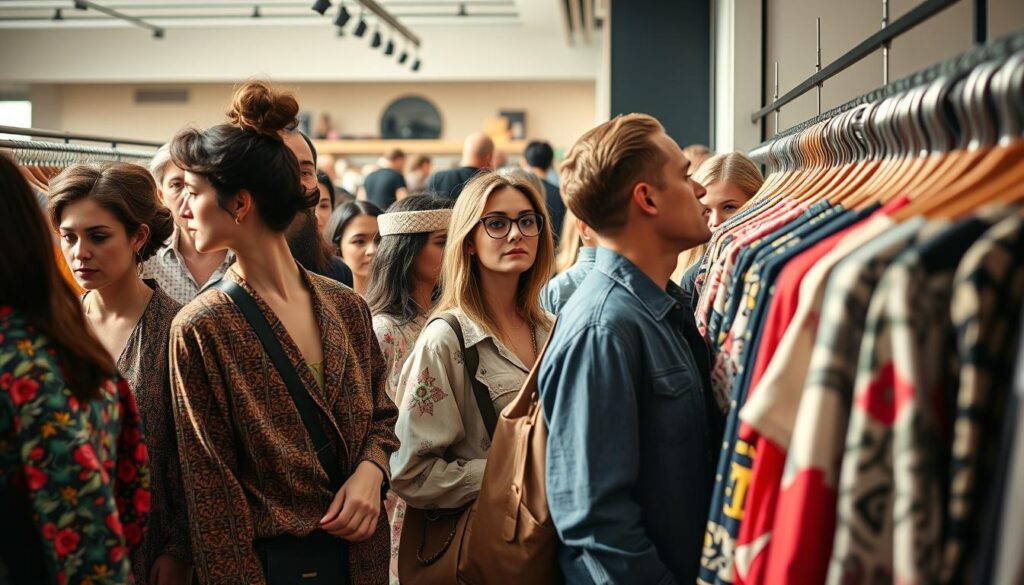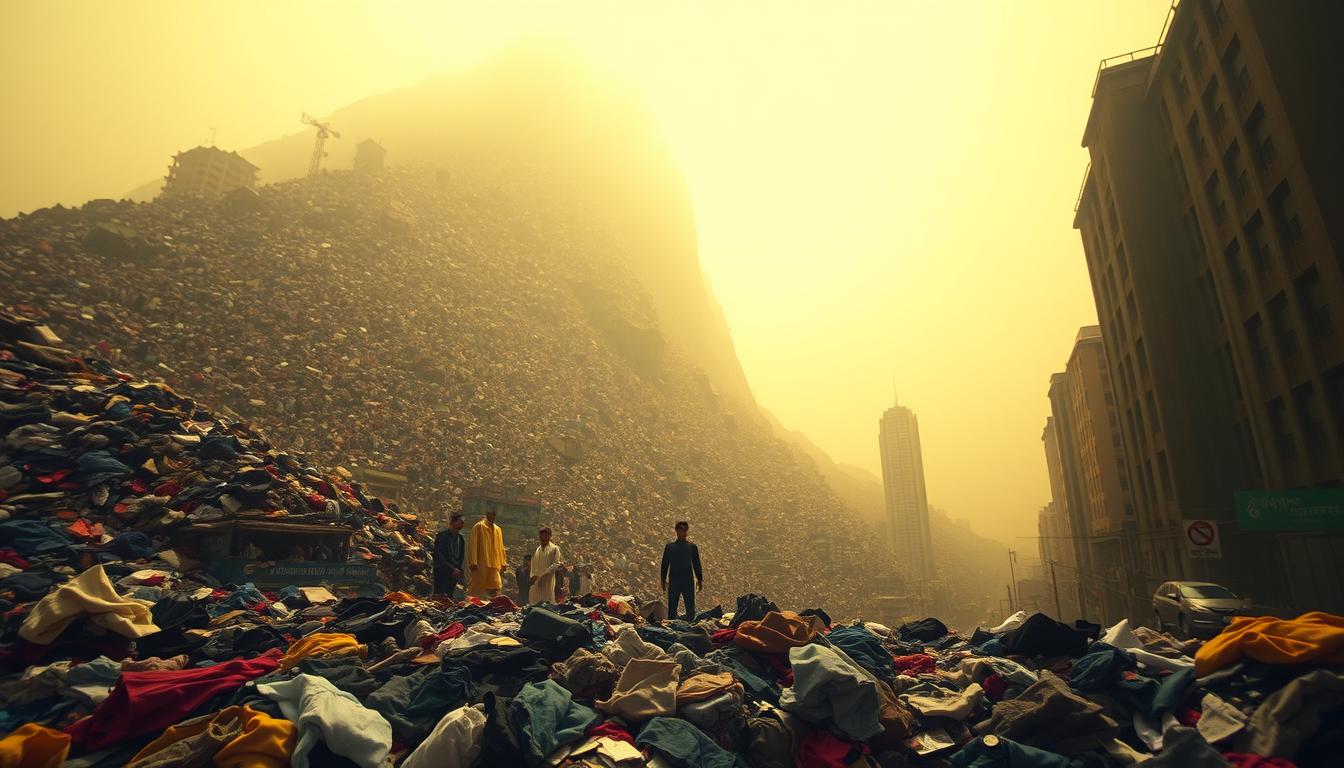Table of Contents
Did you know that the clothes you wear could be harming the planet? The fashion industry, valued at $2.5 trillion, is a major driver of climate change. It’s responsible for 10% of global carbon emissions and consumes vast amounts of water, making it the second-largest water consumer in the world.
Every year, 92 million tonnes of textile waste end up in landfills, overflowing with discarded garments. Brands like Shein have accelerated production cycles, creating new styles in just 10 days. This rapid pace encourages overconsumption and contributes to environmental degradation.
But there’s hope. By understanding the impact of our choices, we can shift toward sustainable practices. From eco-friendly fabrics to circular fashion models, small changes can make a big difference. Let’s explore how we can rethink our approach to clothing and protect the environment.
Key Takeaways
- The fashion industry generates 10% of global carbon emissions.
- 92 million tonnes of textile waste are produced annually.
- Shein’s 10-day production cycle highlights the speed of modern fashion.
- Overconsumption drives environmental damage and landfill overflow.
- Sustainable fabrics and circular models offer actionable solutions.
Introduction to Fast Fashion
Modern clothing production has evolved into a rapid, trend-focused system. This approach, known as fast fashion, prioritizes speed and affordability over sustainability. It’s a model that has reshaped the industry and how we consume clothes.
What is Fast Fashion?
Fast fashion refers to the quick turnaround of trendy, low-cost garments. The term was coined in the 1990s when Zara introduced a 15-day production cycle. This model allows fashion brands to quickly replicate runway styles and make them accessible to the masses.
Before the 1980s, shopping was seasonal, with collections released twice a year. Today, brands like Shein produce new styles in as little as 10 days. This shift has led to an explosion in garment production, with 80 billion new items consumed annually—a 400% increase since 2000.
The Rise of Fast Fashion Brands
Key players like Zara, H&M, and Forever 21 have dominated the market. Shein, with its ultra-fast cycles, has taken this model to the extreme. These brands rely heavily on synthetic materials, with polyester expected to make up 63% of global fiber production by 2025.
The rise of fast fashion has changed consumer habits, encouraging frequent purchases and disposable clothing. While it offers affordability and variety, the environmental and social costs are significant. Understanding this model is the first step toward making more sustainable choices.
The Environmental Impact of Fast Fashion
The fashion industry leaves a heavy footprint on our planet. From excessive water use to harmful emissions, its effects are far-reaching. Understanding these impacts is crucial for making better choices.
Carbon Emissions and Climate Change
The industry is a major source of carbon emissions, contributing 10% of the global total. This is largely due to the reliance on fossil fuels for production and transportation. By 2030, emissions are projected to grow by 60%, worsening the climate crisis.
Water Consumption and Pollution
Producing a single cotton shirt requires 700 gallons of water, while jeans need 2,000 gallons. Dyeing processes are the second-largest global water polluter, releasing toxic chemicals into rivers and oceans. This not only harms ecosystems but also affects communities relying on these water sources.
Textile Waste and Landfill Overflow
Every year, 92 million tonnes of textile waste end up in landfills. Synthetic materials like polyester break down into microplastics, with 35% of ocean microplastics coming from laundry. This equals 500,000 tons of microfibers annually—equivalent to 50 billion plastic bottles.
Leather tanning adds to the problem, leaving a legacy of toxic chemicals. However, sustainable fabrics like hemp, lyocell, and organic cotton offer eco-friendly alternatives. By choosing these materials, we can reduce the environmental harm caused by the industry.
The Social Consequences of Fast Fashion
Behind every trendy outfit lies a story of human struggle. The fashion industry’s rapid growth has come at a significant cost to the workers who make our clothes. From unsafe working conditions to unfair wages, the social impact is profound and far-reaching.

Exploitation of Garment Workers
Most apparel is made by young women aged 18-24, who make up 80% of the workforce. These workers often face long hours, low pay, and hazardous environments. In Bangladesh, many earn as little as $0.12 per hour, a stark contrast to the profits of major brands.
The 2013 Rana Plaza collapse, which killed 1,134 people, exposed the dangers of unsafe factories. Despite global outrage, many workers still face similar risks today. This tragedy highlighted the urgent need for better safety standards in the industry.
Child Labor and Human Rights Violations
Forced labor is prevalent in over 10 countries, according to the U.S. Department of Labor. Many garments are produced in sweatshops in Argentina, China, and Vietnam, where labour laws are often ignored. Children are also exploited, working long hours for little to no pay.
Some brands attempt to mask these issues with “ethical collections,” but this greenwashing often fails to address the root problems. The price of cheap clothing is paid by those at the bottom of the supply chains, while CEOs earn millions.
Tearfund’s research reveals that 40% of New Zealand’s imports are linked to forced labor. This underscores the global scale of the problem and the need for systemic change. By understanding these issues, we can make more informed choices and advocate for fairer practices.
The True Cost of Fast Fashion
The allure of affordable clothing often hides a deeper, more troubling reality. While the price tag may seem low, the true cost of these products extends far beyond what the consumer pays. From water usage to chemical pollution, the hidden expenses are staggering.
Hidden Costs in the Supply Chain
A $5 t-shirt might seem like a bargain, but its production requires 2,700 liters of water. This is just one example of the hidden environmental toll. The supply chains behind these products are riddled with inefficiencies and waste.
Leather tanning, for instance, relies on harmful chemicals like formaldehyde and coal-tar derivatives. These substances not only pollute the environment but also pose health risks to workers. The land and resources used in this process further amplify the true cost of cheap clothing.
The Price of Cheap Clothing
In the U.S., the average person generates 82 pounds of textile waste annually. In Taiwan, this number rises to 75 discarded items per person. Synthetic materials like polyester, derived from petroleum, contribute significantly to this waste.
Mass production models often tout efficiency, but this is a myth. The retail price of clothing rarely reflects its environmental and social impact. By understanding these hidden costs, we can make more informed choices and advocate for sustainable practices.
Fast Fashion vs. Sustainable Fashion
The way we approach clothing has a direct impact on the environment and society. While fast fashion prioritizes speed and low costs, sustainable fashion focuses on ethical practices and long-term quality. This shift is essential for reducing waste and protecting resources.
What is Sustainable Fashion?
Sustainable fashion is a movement that emphasizes eco-friendly materials, fair labor practices, and circular models. Brands like Patagonia and Eileen Fisher lead the way with repair programs and capsule collections. These efforts aim to extend the life of garments and reduce environmental harm.
Innovative materials like Piñatex (made from pineapple fibers) and mushroom leather are transforming the industry. These alternatives offer durability without relying on harmful chemicals or excessive resources. By choosing such designs, consumers can support a greener future.
Key Differences Between Fast and Slow Fashion
Fast fashion thrives on rapid production and low prices, often at the expense of quality. In contrast, slow fashion values craftsmanship and durability. A garment from a slow fashion brand might last a lifetime, while fast fashion items are often discarded after just 10 wears.
Circular models, like Mud Jeans’ lease-and-return program, are redefining ownership. Instead of buying and discarding, consumers can rent or swap clothes. This approach reduces waste and promotes a more sustainable lifestyle.
Legislation is also driving change. The EU’s forthcoming textile sustainability laws aim to hold brands accountable for their environmental impact. By supporting these initiatives, we can create a fashion industry that values both people and the planet.
The Role of Consumers in Fast Fashion
The choices we make as shoppers shape the future of the fashion industry. From the items we buy to the frequency of our purchases, our behavior directly influences production and marketing strategies. Understanding this dynamic is key to creating a more sustainable system.

How Consumer Behavior Drives Fast Fashion
Since 2000, clothing consumption has increased by 400%. The average American buys 68 garments annually, fueling the demand for quick, affordable fashion. Social media platforms like Instagram and TikTok amplify this trend, with 50% of users admitting to impulse buys through shoppable posts.
Brands capitalize on this by releasing new trends at an unprecedented pace. In the UK, 235 million “occasion wear” items are discarded after just one use. This cycle of overconsumption is driven by a culture of FOMO (fear of missing out) and the constant need to stay relevant.
The Psychology of Trend Consumption
Gen Z leads the charge in adopting trends, with a turnover rate 2.5 times faster than older generations. Influencers play a significant role, using psychological hooks to encourage purchases. This creates a culture where clothing is seen as disposable rather than valuable.
However, movements like minimalism and capsule wardrobes are gaining traction. These approaches emphasize quality over quantity, challenging the fast fashion model. By making mindful choices, consumers can reduce their environmental impact and support sustainable practices.
How to Recognize Fast Fashion Brands
Not all clothing brands are created equal—some prioritize speed over sustainability. Understanding the signs of fast fashion can help you make more informed choices and avoid supporting harmful practices.
Identifying Fast Fashion Retailers
Fast fashion retailers often release thousands of new styles each year. For example, SHEIN offers over 600,000 SKUs, while H&M launches 52 micro-collections annually. This overproduction model is a clear red flag.
Another sign is constant discounts and low prices. Boohoo’s £5 dresses may seem like a bargain, but the true cost lies in poor quality and environmental harm. These pieces are designed to be worn a few times before being discarded.
Spotting Greenwashing Tactics
Some brands use misleading marketing to appear eco-friendly. H&M’s “Conscious” collection, for instance, has been criticized for greenwashing. Without third-party certifications like GOTS or B Corp, these claims often lack substance.
To verify a brand’s ethics, check resources like the Tearfund Ethical Fashion Report. Look for transparency in their supply chain and commitment to fair labor practices. This ensures your choices align with your values.
Alternatives to Fast Fashion
The way we shop for clothes is changing, and so are our options. From secondhand shopping to supporting ethical brands, there are many ways to enjoy fashion responsibly. These alternatives not only reduce waste but also promote a more sustainable lifestyle.
Shopping Secondhand and Thrifting
Secondhand shopping is a great way to give clothes a second life. Platforms like ThredUp and Poshmark have resold over 100 million items, proving that pre-loved fashion is in demand. Thrifting also supports local economies and reduces the need for new production.
Supporting Ethical and Local Brands
Choosing ethical brands can make a big difference. Local artisans, like New Zealand’s Starfish and Kowtow, focus on fair labor practices and eco-friendly materials. Supporting these brands helps preserve traditional craftsmanship and reduces environmental harm.
Renting and Swapping Clothes
Rental services like Rent the Runway, with 11 million members, are growing rapidly. The rental market has expanded by 150% year-over-year, offering a sustainable way to enjoy trendy clothes without the commitment. Swapping items with friends or at community events is another eco-friendly option.
By exploring these alternatives, we can reduce our fashion footprint and support a more sustainable future. Small changes in our shopping habits can lead to big impacts for the planet.
Steps to a More Sustainable Wardrobe
Creating a sustainable wardrobe starts with mindful choices and practical steps. By focusing on quality over quantity, we can reduce waste and extend the life of our clothes. This approach not only benefits the environment but also saves money in the long run.
Building a Capsule Wardrobe
A capsule wardrobe is a curated collection of 30-50 versatile clothes that can be mixed and matched. This method reduces consumption and encourages thoughtful purchases. Brands like Patagonia promote durable designs, ensuring each piece lasts for years.
Extending the life of garments by just 25% can cut emissions by 24%. This makes a capsule wardrobe not only practical but also eco-friendly. Start by selecting timeless pieces that suit your style and needs.
Repairing and Upcycling Clothes
Instead of discarding damaged clothes, consider repairing or upcycling them. Techniques like darning and visible mending can breathe new life into old garments. Platforms like Fibershed promote regional fiber systems, supporting local artisans and sustainable practices.
Innovations like Kintra Fibers’ compostable polyester offer eco-friendly alternatives. By repairing and reusing, we reduce textile waste and support a circular fashion model.
Mindful Shopping Habits
Mindful shopping involves analyzing cost-per-wear rather than impulse buying. Opt for quality over quantity, and choose brands with ethical practices. Cold washing and air-drying can also reduce emissions and extend the life of your clothes.
FibreGuard’s stain-resistant technology and Patagonia’s Ironclad Guarantee are examples of sustainable innovations. By adopting these habits, we can make a positive impact on the planet.
Conclusion: Taking Action Against Fast Fashion
The fight against harmful practices in the clothing industry starts with small, actionable steps. From supporting policies like France’s AGEC Law to advocating for fair wages, everyone can contribute to meaningful change.
Legislative wins, such as California’s SB 707 bill, show progress in holding brands accountable. Tools like EarthDay.org’s Fashion Footprint Calculator empower people to measure their impact and make better choices.
Immediate actions like swapping clothes, repairing items, and voting for sustainable policies can drive change. As Vivienne Westwood famously said, “Buy less, choose well.” Together, we can reshape the industry and protect the climate for future generations.
FAQ
What is fast fashion?
Fast fashion refers to the rapid production of inexpensive clothing by brands to keep up with the latest trends. This model focuses on quick turnover and low prices, often at the expense of quality and ethical practices.
How does fast fashion impact the environment?
It contributes to carbon emissions, excessive water use, and textile waste. The industry relies on fossil fuels and synthetic materials like polyester, which harm the planet and accelerate climate change.
What are the social issues linked to fast fashion?
Many garment workers face exploitation, unsafe conditions, and low wages. Child labor and human rights violations are also prevalent in countries where production costs are low.
Why is fast fashion so cheap?
Brands cut costs by using low-quality materials, outsourcing labor to countries with weak labor laws, and prioritizing speed over sustainability. These practices hide the true cost of production.
What is sustainable fashion?
Sustainable fashion focuses on ethical production, eco-friendly materials, and fair labor practices. It aims to reduce environmental harm and promote long-lasting, high-quality garments.
How can I identify fast fashion brands?
Look for retailers that release new collections frequently, offer extremely low prices, and lack transparency about their supply chains. Greenwashing tactics may also disguise unethical practices.
What are some alternatives to fast fashion?
Consider shopping secondhand, supporting ethical brands, renting clothes, or participating in clothing swaps. These options reduce waste and promote sustainable consumption.
How can I build a more sustainable wardrobe?
Focus on quality over quantity, repair or upcycle old clothes, and adopt mindful shopping habits. A capsule wardrobe with versatile pieces is a great way to start.
What role do consumers play in fast fashion?
Consumer demand for trendy, affordable clothing drives the industry. By making conscious choices and supporting ethical brands, individuals can help reduce the negative impact of fast fashion.


